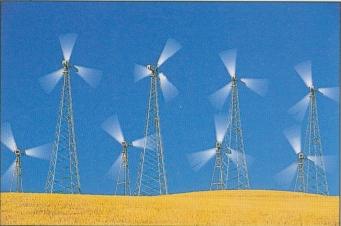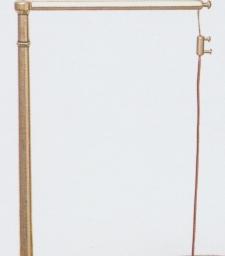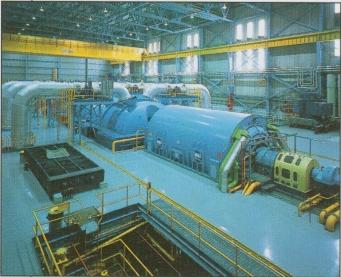| Previous | Index | Next |
MACHINES, EVEN THE MOST FULLY AUTOMATED, do not start working or
continue to operate totally unaided. To produce any action, a machine needs a source of energy. That energy, in the form of movement or electricity, may come from muscles, engines, batteries, or power stations. Machines apply this energy to perform useful tasks. They may use the energy to perform a physical movement, such as turning a wheel, or they may convert the energy into another form for example, microphones are used to convert sound energy into electric signals that can be changed back into sound energy by loudspeakers.
The first source
of energy used to drive machines was muscle power, both human and animal. Even today, it is still commonly used to drive machines in many parts of the world. And even where electricity and other sources of energy are readily available, it is often
easier to work devices such as
can openers and corkscrews by
hand. However, people and beasts
soon tire and cannot provide a
constant flow of energy. About
2,000 years ago, the flow of water
in rivers was put to use to drive
waterwheels that powered
machines. And later, windmills
were used to capture the energy
of moving air. Wind and water
still drive machines
that produce much
of our electricity.
,At power stations, turbines
drive big electrical generators. Such generators produce most of the electrical energy needed to power homes, schools, offices, and factories.
machines need compact and reliable sources of energy that are either part of the machine or can be brought to it. The eighteenth century saw the development of the first such energy source: the steam engine. Steam power is now mainly used to drive generators
in power
stations, having been displaced in the last century by gasoline and diesel engines. The most convenient energy source of all,
electricity, was first
harnessed
in the nineteenth century. Electricity is either
generated in power stations and carried along power lines, or supplied on the spot by batteries. Electric motors now power many kinds of machines, and electricity is essential for computers and communications equipment.
transfers the energy from the source to the place where it is required. Sometimes, the energy travels only a short distance-a screwdriver transfers energy from your hand along the screwdriver to the head of the screw. But energy may also travel world
wide, as it does when a radio or telephone is used. In some cases, a machine may transform energy. When a screwdriver transfers the movement of muscles (kinetic energy) to a screw, there is no change in the kind of energy. But the engine in a car burns fuel to
produce heat energy,
which is changed to kinetic energy
as the engine turns
the wheels. And in a hydroelectric power station, the kinetic energy of moving water drives a turbine that powers a
generator, which turns the kinetic energy into electricity.
Mechanical marvels
An efficient machine gets the right amount of energy to
the right place. Many machines do this using mechanical parts, such as levers, gears, or pulleys. These machines often produce more force or speed than the energy source that powers them. For example, a bicycle uses a
Wind turbines are modern versions of the ancient windmill. Both capture wind energy to provide power to drive machines-the windmill directly, and the turbine by generating electricity.
New power
Although rivers and winds can be powerful, they are not always constant or convenient energy sources. Few locations are blessed with swift rivers, and winds often drop without warning. To be of real service to us,
The first electric motor was
invented by the British scientist Michael
Faraday in 1821. In this machine, a wire
carrying an electric current rotated
around a magnet.
Energy transfers
Every machine has one basic purpose: to take energy from a source and use it to perform a task. In doing so, the machine




| Previous | Index | Next |